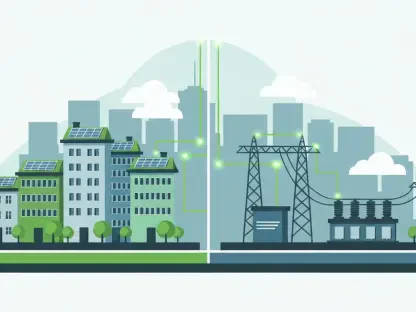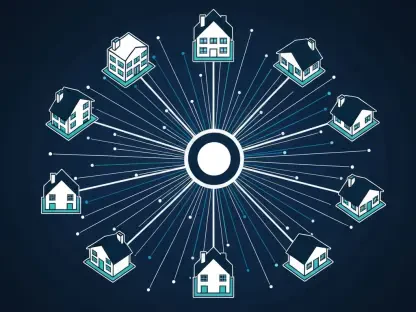In an era where energy efficiency takes center stage, a Colorado-based firm’s partnership with the National Renewable Energy Laboratory (NREL) defines a pivotal move in the industry. The collaboration comes as part of the Wells Fargo Innovation Incubator (IN2) Program, a beacon for innovative technology firms aiming to transform their sectors. Centering on Aspen-based EdgePower, the partnership takes an unexpected turn by straying from conventional validation methods for building energy management systems and introducing an innovative simulation technique termed “controller-in-the-loop.” This new approach employs NREL’s proficiency in building simulation, equipping EdgePower to test its systems virtually and redefine conventional boundaries in testing and validation. This progression points toward a future where energy management systems can be optimized without stepping foot in a physical site, thereby opening doors to a new frontier in building energy management technology.
Virtual Simulation Techniques
Historically, the validation of building energy control systems necessitated hardware-in-the-loop (HIL) setups that integrated physical devices into simulated settings. This process often presented logistical and financial constraints, requiring substantial resources to test various scenarios. However, EdgePower’s novel controller-in-the-loop simulation disrupts this traditional model. By leveraging advanced virtual simulation techniques, EdgePower accelerates the testing and validation processes and overcomes physical limitations inherent in HIL setups. With this approach, the system’s hardware and software, designed to minimize demand charges and enhance energy efficiency, undergo rigorous testing across different virtual simulations of building types, eliminating the necessity for physical hardware integration. Thus, the firm can rapidly iterate and refine its systems, providing a level of flexibility and efficiency previously unattainable in the building energy management sector.
Dane Christensen, a prominent engineer at NREL and the lead investigator for the project, emphasizes the versatility of the controller-in-the-loop method. By emulating diverse building settings—whether it’s a federal building in Denver or a school in Florida—this simulation grants NREL researchers remote access to observe and evaluate the impacts of EdgePower’s control architecture on buildings’ energy efficiency and utility costs. Eschewing site-specific hurdles like cybersecurity checks, permissions, and commissioning delays, the emphasis is on efficiency and speed. This efficiency not only expedites the iteration process but also enhances the system’s adaptability across multiple scenarios, contributing significantly to the understanding of how EdgePower’s solutions fare in real-world applications.
Collaborative Insights on Energy Efficiency
The collaboration between EdgePower and NREL underlines a mutual exposure to fresh insights into energy management’s ever-evolving domain. The significance of this partnership is grounded in its potential to optimize energy efficiency, where virtual simulations allow EdgePower to delve deeper into their systems’ impacts on various buildings. By undertaking this extensive testing process, the firm gains an enriched understanding of the environmental implications, operational advantages, and cost-effectiveness associated with their solutions. The collaboration also aims to streamline product refinement, ensuring their offerings align seamlessly with the diverse needs of end users, ranging from Fortune 500 companies to educational institutions.
This initiative’s success is evident as EdgePower integrates its technology within over 500 sites, already reporting impressive results in demand charge reduction through sophisticated control and analytics. As part of IN2’s third cohort, EdgePower’s involvement with NREL highlights the program’s efficacy in fostering technological advancement. With NREL’s support, there’s potential for further expansion, with the analysis of potential client sites poised for new demonstration facilities. This strategic move further underscores EdgePower’s ambition to scale its operations and refine its services to enhance energy efficiency and cost reduction across varied client bases.
Bolstering Cybersecurity and Broader Impacts
Recognizing cybersecurity’s growing importance in energy management, NREL intends to conduct a comprehensive risk assessment of EdgePower’s systems. Such assessments serve a dual purpose: they ensure data security for the firm while offering a credible third-party evaluation that attests to the systems’ resilience against cybersecurity threats. By establishing trust and security with potential clients, EdgePower aims to solidify its market position, alleviating concerns regarding data vulnerabilities that often accompany innovative technological solutions in the modern era. This initiative reflects an understanding that cybersecurity is not merely a technical necessity but a foundational element of consumer trust and business success.
NREL’s broader role in advancing energy efficiency becomes evident through collaborations like this. Acting as a linchpin in integrating renewable power technologies within buildings, schools, and entire communities, NREL’s R&D capabilities promote reliability and sustainability within energy systems. A testament to this is the Energy Systems Integration Facility (ESIF), recognized for its megawatt-scale research capacity. It provides an ideal environment for full-power integration studies and real-time simulations, enabling unparalleled collaborative efforts among industry, academia, and government entities. The outcome is a ripple effect of innovation, fostering significant advancements and addressing global energy challenges proactively.
Pioneering a Future of Sustainable Energy Solutions
Traditionally, validating building energy control systems involved hardware-in-the-loop (HIL) setups, integrating physical components into simulated environments. This method presented challenges due to logistical demands and financial costs, requiring significant resources to test various scenarios. EdgePower has revolutionized this approach with its innovative controller-in-the-loop simulation. By using cutting-edge virtual simulation techniques, EdgePower speeds up testing and validation processes while overcoming the physical limitations of HIL setups. This method allows for rigorous testing of both hardware and software components across virtual simulations of different building types, eliminating the need for physical hardware. As a result, EdgePower can rapidly iterate and improve its systems, offering unprecedented flexibility and efficiency in building energy management. Dane Christensen, a leading engineer at NREL and project head, highlights the versatility of this method. Simulating different building environments enables NREL researchers to remotely assess EdgePower’s impact on energy efficiency and utility costs. This approach bypasses hurdles like cybersecurity checks and commissioning delays, focusing on speed and adaptability, thus enhancing real-world application insights.









